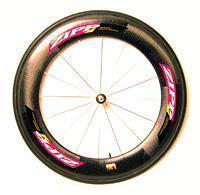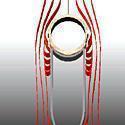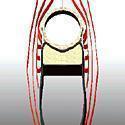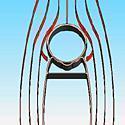
Recently on Cyclingnews.com |
91st Tour de France - July 3-25, 2004
Tour tech - June 29, 2004
Edited by John Stevenson
Got tech? Send press releases, news, and tech questions to the Cyclingnews tech-heads.
Zipp to roll out fast new wheel for Tour prologue

|
When the Tour de France prologue rolls out in Ličge on Saturday, Tyler Hamilton and other riders sponsored by US aero wheel maestros Zipp will have a new weapon in their arsenal, a wheel that Zipp claims is worth 16-17 seconds over 40km, the new 808.
If that doesn't sound like a vast amount, compared to the gains made in aero components in the past, that reflects just how good modern aerodynamic components have become, according to Zipp design and development engineer Josh Poertner. "There is great difficulty finding improvements in the bike-rider system as all the components become so specialized," says Poertner. "Everybody wants to have a product that will save you a minute in 40km, but the reality is that there is no one minute left. The drag numbers are so low and the top products are so good, that major improvements in a single component are rather small in the big picture. But then again, 17 seconds could also be really huge depending on the situation."
Lest anyone forget, Tours de France have been won by smaller margins - Greg LeMond's eight-second victory over Laurent Fignon in 1989 is the most famous example. And Poertner's not talking about a 17-second improvement compared to a regular spoked wheel, but an advantage over three-spoke wheels or Zipp's own 404 wheel.
|
|
|
|
|
Two technologies give the new wheel its extra turn of speed, and both are notions that Zipp has been working on for some time, given a final push into reality by Tyler Hamilton's riding in last year's Tour. "We were all enthralled with the Tour, and really overwhelmed by the courage and performance that Tyler put in. I remember watching the final TT and thinking that Tyler, Jan and Lance were all riding wheels which, despite looking dramatically different, were all pretty similar in performance, based on our wind tunnel data from the previous winter."
The first important new aspect of the 808 rim is the shape. Instead of having a bulge with parallel sidewalls at the brake track, the 808 has a smooth, uniform bulge that incorporates the tyre into the shape of the rim so that air flows smoothly over the whole assembly.
The enemy aerodynamic designers are always trying to combat is drag. The Holy Grail is persuade air to flow smoothly over a surface, without breaking away and splitting up into the eddies that cause drag. The 808's design reduces drag by keeping the flow attached to the rim. This is an improvement on Zipp's previous 404 design, where the air flow breals away as it passes over the flat brake track, then reattahces at the bulge.
"By blending the rim shape into the tire, we instantly eliminated a lot of issues, particularly the problems associated with air separation off of the tire itself," says Poertner. "Most straight sided and V shaped rims will never really see the airflow, because the tire causes the air to separate, and the rim sort of drafts in the tire wake. These designs can still be more aerodynamic than traditional wheels as they use fewer spokes, and the spokes are shorter, but you will never truly optimize the whole wheel as a system."
The other weapon in the 808's armoury is one that's instantly familiar to anyone who's ever played golf: dimples. A dimpled golf ball travels further than a smooth one because the dimples keep the flow of air over the ball attached for longer, reducing the drag-causing eddies behind the ball. Zipp introduced a dimpled disc wheel a couple of years ago, and Poertner and his team have found that a dimpled rim has big advantages in cross-winds.
"Once we had a design which allowed the air to flow on the rim surface even at low angles, we knew that the dimples would make the thing faster by allowing the air to remain on the contour throughout the rest of the flow. Most rims show flow separation at 2-5 degrees, and this separation causes drastic increases in drag, whereas with the 808 design, we were in the wind tunnel seeing attached flow at 15 degrees."
Poertner doesn't believe riders will use a wheel with a section this big - the 808's rim is 81mm deep - in extremely windy situations, so that 15 degree angle fits the intended use for the wheel, as a even relatively strong cross-wind doesn't 'appear' to the wheel to come at an angle greater than 20 degrees. He also points out that while three- and four-spoke composite wheels are aerodynamically superior to a deep-rim wheel like the 808 only in strong winds, riders tend not to use such composite wheels when it's windy either. The target of the wheel being fastest in conditions up to 15 degree winds therefore reflects "95% of real life conditions" he says.
Nevertheless, figuring out how to actually manufacture the bulged, dimpled rim proved challenging. "Since nobody had ever attempted anything like this before, we had to not only design and develop the rim, but then figure out how in the world to make the tooling that we needed, not at all an easy task," says Zipp president Andy Ording. "The disc tooling is nearly crazy to manufacture, taking hundreds of hours, so we really had our work cut out for us in dimpling not just a flat tool, but one with a highly complex curvature."
Ording and Poertner claim the end result is worth it. The 808 performs as well or better than a disc out to 13 degrees of yaw (wind angle), they say.
For the team at Zipp, it's about returning the inspiration that riders such as Tyler Hamilton provide. "I want our athletes to know that they have the fastest, lightest wheels in the world," says Poertner, adding with a sly nod at one of his favourite movies, "I want them to realize that they can take their performance to the highest level - they can turn it up to 11!"



